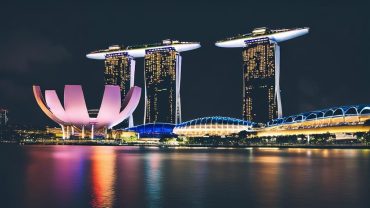Dubai’s diverse array of temples has become a focal point for devotees seeking spiritual fulfillment in the city. The intricate architectural designs and historical significance of these sacred sites offer a glimpse into the rich tapestry of faiths that coexist in Dubai. As worshippers flock to these temples for solace and community, the spiritual resonance of these places transcends cultural boundaries, creating an atmosphere of unity and reverence. The allure of these temples goes beyond their physical presence, drawing in visitors with promises of cultural enrichment and spiritual enlightenment.
Key Takeaways
- Temples in Dubai symbolize cultural diversity and religious tolerance, uniting the Hindu community and fostering a sense of belonging.
- Devotee rituals include traditional practices like Aarti ceremonies, hymn recitations, and offerings, enhancing spiritual experiences.
- Temple architecture in Dubai showcases intricate Hindu designs, vibrant colors, and ornate decorations, reflecting the rich cultural heritage of Hinduism.
- Dubai’s temples, like the Shirdi Sai Baba Temple, embody the city’s openness to diverse religious practices, promoting coexistence and unity among different faiths.
Hindu Temple in Bur Dubai
The Hindu Temple in Bur Dubai stands as a significant religious landmark, serving as the sole Hindu temple in the country and attracting devotees seeking spiritual solace and connection within Dubai’s diverse religious landscape. The temple’s architecture showcases traditional Hindu design elements, including intricate carvings, vibrant colors, and symbolic representations of deities. The cultural significance of this temple lies in its role as a hub for the Hindu community, providing a space for worship, festivals, and spiritual gatherings. Devotees find a sense of belonging and continuity of tradition within the temple’s walls, fostering a deep connection to their faith and heritage. Through its architectural beauty and cultural importance, the Hindu Temple in Bur Dubai stands as a proof to the rich tapestry of religious diversity present in the city.
Mahamevnawa Buddhist Monastery in Jumeirah
Nestled within the vibrant neighborhood of Jumeirah, Mahamevnawa Buddhist Monastery stands as a serene sanctuary of spiritual reflection and cultural heritage. The monastery offers a tranquil space for meditation practices, attracting devotees seeking inner peace and mindfulness. It serves as a hub for the Buddhist community in the UAE, providing a place for cultural celebrations and religious gatherings. Throughout the year, the monastery hosts various events that showcase Buddhist traditions and rituals, fostering a sense of unity and belonging among its followers. The serene ambiance of Mahamevnawa Buddhist Monastery in Jumeirah not only promotes spiritual growth but also preserves the rich cultural heritage of Buddhism in the heart of Dubai.
Other Temples in Dubai
Amidst Dubai’s diverse religious landscape, several temples beyond the well-known ones cater to the spiritual needs of devotees. These temples not only serve as places of worship but also stand as architectural marvels, reflecting cultural significance. The intricate temple architecture showcases a blend of traditional designs with modern elements, providing devotees with a serene and sacred space for prayer and reflection. Each temple holds its unique cultural significance, attracting devotees from various backgrounds seeking spiritual fulfillment. Below is a glimpse of some of the lesser-known temples in Dubai:
| Temple Name | Location |
|---|---|
| Jain Temple | Karama |
| Gurudwara Temple | Jebel Ali |
| St. Mary’s Church | Oud Metha |
| Mar Thoma Church | Jebel Ali |
| Al Mamzar Mosque | Al Mamzar |
Shiva Temple in Bur Dubai
Dubai’s lesser-known temples, such as the Shiva Temple in Bur Dubai, exemplify the city’s rich cultural tapestry and spiritual diversity. The Shiva Temple prominently features the Shiva Linga, a sacred symbol representing Lord Shiva’s energy and presence. The significance of the Shiva Linga lies in its representation of the infinite nature of Shiva and the cosmic principles he embodies. The temple’s architecture design reflects traditional Hindu styles, with intricate carvings and vibrant colors adorning the walls. Images of various Hindu deities surround the Shiva Linga, creating a spiritually immersive experience for devotees. The temple ground sees a surge in activity during festivals, with devotees flocking to pay homage to Lord Shiva and seek blessings for prosperity and well-being.
Shirdi Sai Baba Temple Details
The Shirdi Sai Baba Temple in Dubai serves as a revered place of worship for the Hindu community, attracting devotees seeking solace and spiritual guidance. The temple embodies the spiritual teachings of Shirdi Sai Baba, known for his message of love, forgiveness, and charity. Devotees engage in devotional practices such as offering prayers, performing rituals, and participating in bhajans to connect with the divine. The temple’s ambiance, adorned with idols and images of Hindu deities, creates a sacred space for reflection and worship. Shirdi Sai Baba’s iconic presence is a focal point, symbolizing his spiritual grace and blessings. Regular visits by devotees highlight the temple’s significance as a hub for spiritual growth and communal devotion.
Essential Idol: Shiva Linga
Embodying profound symbolism and spiritual significance, the Shiva Linga stands as a revered and essential idol within the sacred confines of the Shiva Temple in Dubai. The Shiva Linga symbolism encompasses the representation of the formless and eternal nature of Lord Shiva, symbolizing his cosmic presence. In temple architecture trends, the Shiva Linga is often placed at the center of the sanctum sanctorum, surrounded by images of various Hindu deities. Devotees pay homage to the Shiva Linga with offerings and prayers, seeking blessings for health, prosperity, and spiritual well-being. The intricate design and placement of the Shiva Linga within the temple reflect the rich cultural heritage and architectural traditions of Hindu worship spaces.
| Shiva Linga Symbolism | Temple Architecture Trends | Devotee Offerings |
|---|---|---|
| Represents Lord Shiva’s eternal nature | Placed at the center of the sanctum | Offer prayers and offerings |
| Symbolizes cosmic presence | Surrounded by Hindu deity images | Seek blessings for well-being |
| Signifies formlessness | Reflects rich architectural traditions | Express gratitude through rituals |
Hindu Deity Images in Shiva Temple
Within the sacred confines of the Shiva Temple in Dubai, the presence of Hindu deity images adds a layer of spiritual richness and cultural significance to the temple’s ambiance. These images play an important role in Hindu rituals and symbolize various aspects of spirituality. Here are four key points to shed light on the importance of Hindu deity images in the Shiva Temple:
- Representation of Gods: The images depict different deities, showcasing the diversity within Hinduism.
- Aesthetic Beauty: The artistic representations enhance the visual appeal of the temple, creating a serene atmosphere for devotees.
- Spiritual Connection: Devotees use these images as focal points for their prayers, fostering a deeper connection with the divine.
- Cultural Preservation: The presence of these images preserves and promotes Hindu traditions and beliefs in the community.
Devotee Attendance at Shiva Temple
Evidencing the cultural vibrancy and religious devotion in Dubai, the Shiva Temple garners significant attendance from devotees seeking spiritual solace and community connection. Devotees partake in various rituals, such as offering prayers to the Shiva Linga and other Hindu deities present within the temple. Spiritual gatherings during festivals witness a surge in attendance, creating a vibrant atmosphere of devotion and cultural celebration. The temple serves as a focal point for the Hindu community in Dubai, providing a space for collective worship and reflection. Devotees find solace and a sense of belonging in the shared experience of attending the temple, fostering a strong sense of community and religious identity among the worshippers.
Shirdi Sai Baba Temple Overview
The Shirdi Sai Baba Temple in Dubai serves as a spiritual sanctuary for devotees seeking solace and connection within the Hindu community.
- Devotee Rituals:
- Devotees engage in traditional practices like offering flowers, lighting incense, and performing Aarti ceremonies.
- Temple Architecture:
- The temple boasts traditional Hindu architecture with intricate carvings and vibrant colors, creating a serene ambiance for worship.
- Cultural Significance:
- The temple symbolizes unity and faith within the Hindu community in Dubai, attracting devotees from diverse backgrounds.
- Historical Context:
- The presence of the Shirdi Sai Baba Temple alongside other Hindu temples in Dubai highlights the city’s multicultural environment and religious tolerance.
Worship Offerings at Shirdi Sai Baba Temple
Nestled within the vibrant cultural tapestry of Dubai, the worship offerings at the Shirdi Sai Baba Temple serve as a profound expression of devotion and spiritual reverence among the Hindu community. The temple’s worship practices encompass a blend of traditional rituals and modern spiritual offerings, creating a sacred space for devotees to connect with the divine. From lighting incense sticks and offering flowers to performing aarti ceremonies and reciting sacred hymns, worshippers engage in a variety of spiritual activities to honor Shirdi Sai Baba and seek blessings for their well-being. These worship practices not only foster a sense of community among devotees but also provide a profound spiritual experience that resonates deeply with the cultural heritage of the Hindu faith.
Prominence of Shirdi Sai Baba Icon
Within the vibrant cultural milieu of Dubai’s Shirdi Sai Baba Temple, the icon of Shirdi Sai Baba stands as a revered symbol of devotion and spiritual significance for the Hindu community. This iconic devotion is deeply rooted in the following aspects:
- Historical Reverence: The presence of Shirdi Sai Baba’s icon invokes a sense of historical reverence among devotees, connecting them to the saint’s teachings and miracles.
- Interfaith Harmony: The spiritual significance of the icon transcends religious boundaries, fostering interfaith harmony and unity among worshippers.
- Symbol of Compassion: Shirdi Sai Baba’s image symbolizes compassion and selfless service, inspiring devotees to emulate these virtues in their lives.
- Guiding Light: Many see the icon as a guiding light, providing solace, hope, and spiritual guidance to those who seek it.
Regular Devotee Visits to the Temple
Frequent visits by devout followers to the Shiva Temple in Dubai underscore the temple’s significance as a hub of spiritual devotion and communal worship. The temple offers a space for devotees to engage in meditation practices, fostering a serene environment for introspection and spiritual growth. Regular gatherings for communal prayers and ceremonies provide a sense of belonging and shared faith among worshippers. Additionally, the temple serves as a venue for spiritual retreats, allowing individuals to deepen their connection with the divine and rejuvenate their inner selves. Through these consistent visits, devotees not only uphold their religious traditions but also find solace and peace in the spiritual sanctuary that the Shiva Temple in Dubai provides.
Top Hotels Near Dubai Temples
In close proximity to the diverse temples in Dubai, a selection of top-tier hotels offer luxurious accommodations for visitors seeking a harmonious blend of spiritual exploration and relaxation.
- Burj Al Arab: Known for its opulent design and impeccable service, this iconic hotel provides a lavish stay with stunning views of the Arabian Gulf.
- Palace Downtown: Nestled near the Dubai Mall, this hotel exudes Arabian elegance and offers a tranquil escape amidst the bustling city.
- Jumeirah Emirates Towers: Situated near the Mahamevnawa Buddhist Monastery, this hotel caters to business and leisure travelers with its modern amenities and exceptional service.
- Four Seasons Resort Dubai at Jumeirah Beach: With a prime location near the Shiva Temple, this luxurious resort boasts beachfront views and unparalleled hospitality for a memorable stay.
These hotels not only offer comfortable hotel accommodations but also convenient travel arrangements for visitors exploring Dubai’s temples.
Frequently Asked Questions
What Are the Opening Hours of the Hindu Temple in Bur Dubai?
The Hindu temple in Bur Dubai offers worship timings catering to devotees. The temple provides essential facilities for prayer and cultural events. Its cultural significance and community outreach make it a revered place for the Hindu community in Dubai.
Are There Any Specific Rituals or Ceremonies Held at the Mahamevnawa Buddhist Monastery in Jumeirah?
Meditation practices and cultural celebrations are integral to the Mahamevnawa Buddhist Monastery in Jumeirah. The monastery fosters community outreach by offering spiritual teachings. Through traditional rituals and ceremonies, devotees engage in profound spiritual experiences, enhancing their connection to Buddhism.
Do the Other Temples in Dubai Cater to Specific Hindu Sects or Deities?
Various temples in Dubai cater to specific Hindu sects by focusing on particular deities. This diversity showcases cultural nuances and religious practices within the Hindu community. The temples serve as hubs for devotees to connect with their chosen sects and deities.
Can Visitors Participate in Any Special Events or Festivals at the Shiva Temple in Bur Dubai?
Visitors to the Shiva Temple in Bur Dubai can immerse in cultural celebrations and actively participate in Hindu festivals. The temple offers opportunities for devotees to engage in vibrant rituals, enhancing their spiritual experiences.
Are There Any Accommodation Options Available Near the Shirdi Sai Baba Temple in Dubai?
Accommodation options near the Shirdi Sai Baba Temple in Dubai include hotels near Dubai Mall, Burj Al Arab, Mall of the Emirates, and Global Village DUBAI. These hotels provide convenient stays for devotees visiting the temple.





Comment (0)